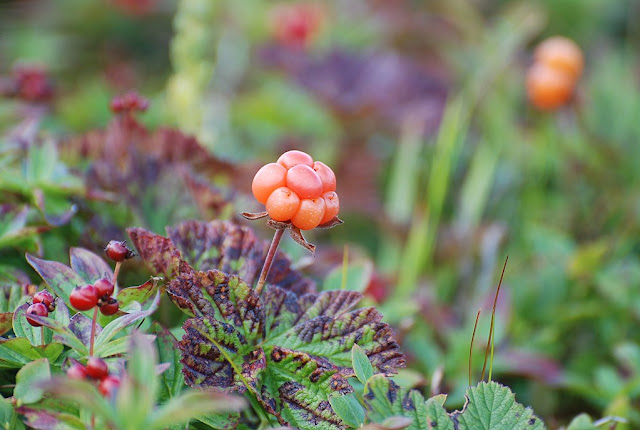This delicate flowering plant produces amber-colored edible fruit that is highly prized as a culinary component, for its wealth of vitamins, and for its medicinal use. They are often referred to as the gold of the Arctic as they are an important part of the culture of northern indigenous people including the Cree, Micmac, and the Inuit.
Cloudberry or Rubus chamaemorus is a species of flowering plant in the rose family that is native to cool temperate areas including the Arctic and Alpine environments. Although it is called a berry, it is actually considered a fruit, or more precisely a cluster of fruits with stones. The fruit requires pollination from a male plant. This delicate plant grows up to ten inches high and has leaves that alternate between lobes. After pollination, white flowers emerge and form raspberry-sized fruit that consists of 5 to 25 drupelets. The fruit is initially pale red and ripens to an amber color in the early autumn. Cloudberries spread through their rhizomes that can grow up to 33 feet long. They grow in bogs, marshes, wet meadows, and in the tundra.
Cloudberries can be found throughout the northern hemisphere. In Europe, they grow in the Nordic countries, Iceland and Greenland, the Baltic states, and across Russia and as far south as Japan. They can also be found in the Scottish Highlands and in Germany's Weser and Elbe Valleys. In North America, they grow wild across northern Canada, Alaska, northern Minnesota, New Hampshire, Maine, and New York.
Medicinal & Culinary Uses
The Cree Woodlands make a decoction of the roots and use it as a "woman's medicine" and to help ease hard labor. A decoction of the root and leaves were made into a drink and given to barren women as a stimulant. The Micmac made a tea from the roots and used it as cough medicine; roots were also used to treat fever and consumption. The Inuit usually found cloudberries near the shore of lakes or by the sea and would make a good-tasting tea from the entire plant. A tea made from leaves picked in the fall is drunk to treat kidney ailments, stomachaches, and general ailments.
Cloudberries are made into jam and used as a sweetener. They are eaten raw or frozen for winter food. They would be preserved alone or in grease and stored in a birchbark basket in an underground cache. Arctic Yup il mixed the berries with seal oil or reindeer fat and sugar to make akutaq (ice cream). The Inupiat added the berries to fluffy fat and ate this mixture as ice cream or would mix them with blackberries and preserve them in a barrel for winter use.
Did You Know
Cloudberries are also called bake-apple, baked-apple berry, salmonberry, knot berry, aqpik or nordic berry.
In Nordic countries, cloudberries are used as a flavoring for akvavit.
In northeastern Quebec, there is a cloudberry liqueur known as chicoutai.
In Norway, it is illegal to pick cloudberries that are not ripe.
Cloudberries contain four times as much vitamin C as an orange.
Cloudberry cream is the national dessert of Norway.





No comments:
Post a Comment